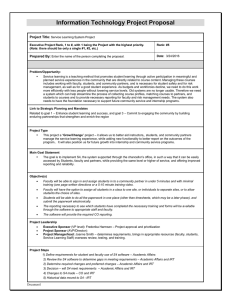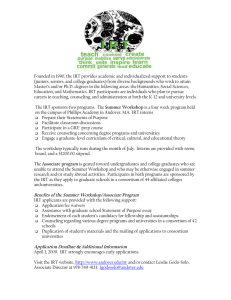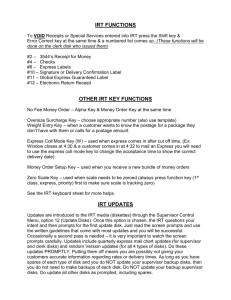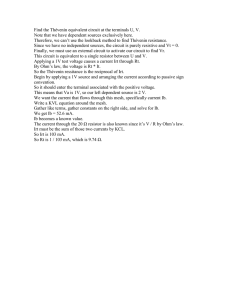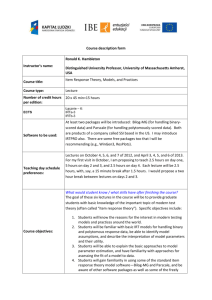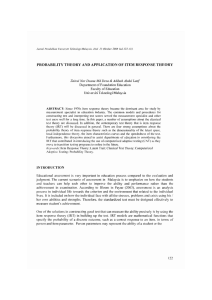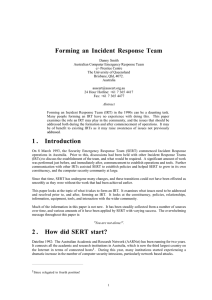Item ResponseTheory (Code:…..) Physics Education Study Program Faculty of Mathematics and Science
advertisement
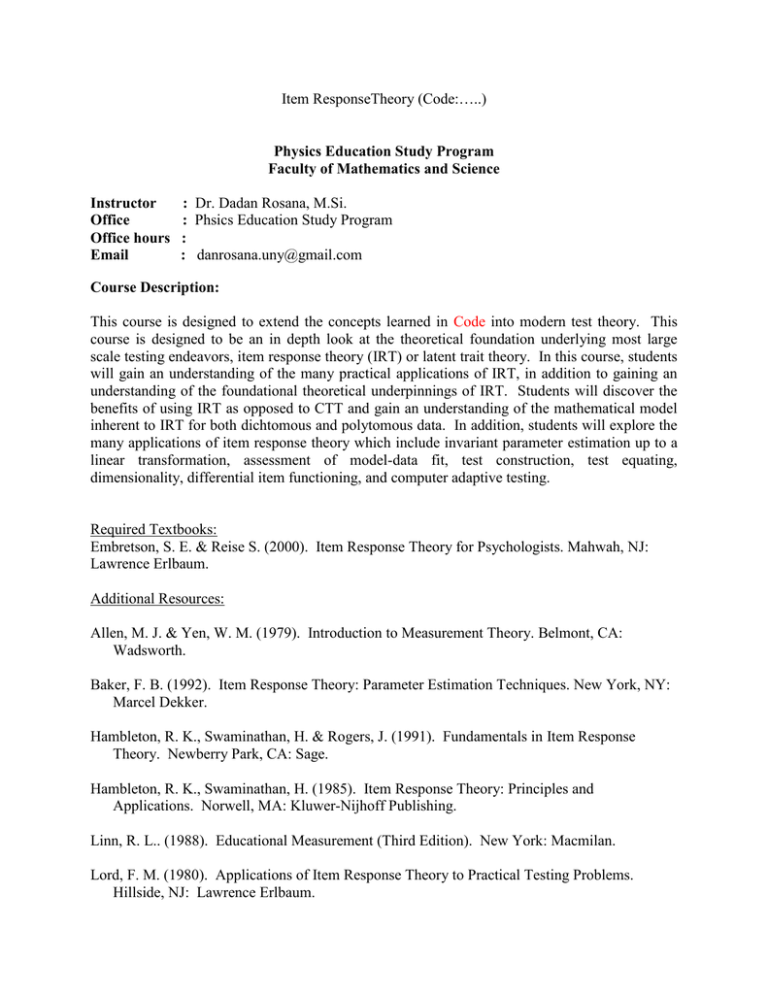
Item ResponseTheory (Code:…..) Physics Education Study Program Faculty of Mathematics and Science Instructor Office Office hours Email : Dr. Dadan Rosana, M.Si. : Phsics Education Study Program : : danrosana.uny@gmail.com Course Description: This course is designed to extend the concepts learned in Code into modern test theory. This course is designed to be an in depth look at the theoretical foundation underlying most large scale testing endeavors, item response theory (IRT) or latent trait theory. In this course, students will gain an understanding of the many practical applications of IRT, in addition to gaining an understanding of the foundational theoretical underpinnings of IRT. Students will discover the benefits of using IRT as opposed to CTT and gain an understanding of the mathematical model inherent to IRT for both dichtomous and polytomous data. In addition, students will explore the many applications of item response theory which include invariant parameter estimation up to a linear transformation, assessment of model-data fit, test construction, test equating, dimensionality, differential item functioning, and computer adaptive testing. Required Textbooks: Embretson, S. E. & Reise S. (2000). Item Response Theory for Psychologists. Mahwah, NJ: Lawrence Erlbaum. Additional Resources: Allen, M. J. & Yen, W. M. (1979). Introduction to Measurement Theory. Belmont, CA: Wadsworth. Baker, F. B. (1992). Item Response Theory: Parameter Estimation Techniques. New York, NY: Marcel Dekker. Hambleton, R. K., Swaminathan, H. & Rogers, J. (1991). Fundamentals in Item Response Theory. Newberry Park, CA: Sage. Hambleton, R. K., Swaminathan, H. (1985). Item Response Theory: Principles and Applications. Norwell, MA: Kluwer-Nijhoff Publishing. Linn, R. L.. (1988). Educational Measurement (Third Edition). New York: Macmilan. Lord, F. M. (1980). Applications of Item Response Theory to Practical Testing Problems. Hillside, NJ: Lawrence Erlbaum. Course Requirements: A. Homework (35% of grade) Homework will be periodically assigned after class to be turned in the following class. Each assignment is designed to help enforce what we are discussing in class and to prepare you for the exam and your project. You are encouraged to work with others on these assignments. Each homework problem will be scored using the following 4-point rubric and your final homework score will be the average of each item level score: 4 points (Excellent) All computations are correct. Interpretations of results and/or answers to questions are thorough, clear, are demonstrate a clear conceptual understanding. 3 points (Good) All computations are conceptually correct. For the most part interpretations of results and/or answers to questions are complete and demonstrate conceptual understanding, although some parts may not be clear or a minor omission may have been made. 2 points (Fair) Either a computational error demonstrates a misunderstanding OR answer is not complete or demonstrates a misunderstanding. 1 point (Poor) A computational error demonstrates a misunderstanding AND answer is not complete, or demonstrates a misunderstanding. 0 points Not done B. Midterm (35% of grade) There will be one take home exam. This exam will be open-book, meaning you will be able to use any references (i.e., books, notes, articles) you think will be helpful during the exam. However, it is expected that you work alone. C. Final Project (30% of grade) Each student will be required to conduct a systematic analysis of test or survey data using an application of item response theory in their area of interest. What type of analysis you decide to do will depend largely on the type of data you choose to work with and your research interests. You must turn in a proposal of your project before completing it. This will allow you to receive feedback and ideas. You may turn in your proposal anytime before the due date if you wish to get started early. Explicit details and scoring rubrics for this project will be handed out later in the course. You will be expected to write up the results of your analyses in a publishable format and to present your findings to the class. Course Grade: Most assignments will be graded using a 4-point scoring rubric, comparable to what is used to grade homework. Any assignment that is not scored using a 4-point scoring rubric will be rescaled to be on a 4-point scale. Your homework assignments will first be averaged and this average score will be used as your homework score. Grades will be based on a weighted average of the homework, midterm exam, and the final projects using the following grading policy. 4.0 – 3.8 = A 3.79 = 3.6 = A3.59 – 3.4 = B+ 3.39 – 3.2 = B 3.19 – 3.0 = B2.99 – 2.7 = C+ 2.69 – 2.3 = C 2.29 – 2.0 = C1.99 – 1.7 = D+ 1.69 – 1.3 = D 1.29 – 1.0 = DTentative Course Schedule: Week 1 2 3 4 5 6 7 8 9 10 11 12 13 14 15 16 Topic Comparison of CTT and IRT Introduction to IRT Model – Based Measurement IRT for Dichotomous Items The Ability Scale Estimation Assessing Model Fit Assignment Chapters 1 and 2 Chapters 3 and 4 Chapter 6 Chapters 7 and 8 Chapter 9 Chapter 7 – Technical Apendix Item/Test Information and Efficiency ***Midterm handed out*** Software for Estimating Ability and Chapter 13 (pp.330 – 337) Parameters (Dichotomous Items) ***Midterm due*** MID TEST Polytomous IRT Models Chapter 5 Chapter (pp. 339 - 344) (ER) Software for Estimating Ability and ***Final Project Description handed Parameters (Polytomous Items) out*** Chapter 9 (HS) Equating ***Final Project Proposals Due*** Differential Item Functioning Chapter 8 (HS) Computerized Adaptive Testing2 Chapter 10 (HS) Computerized Adaptive Testing2 Chapter 10 (HS) Class Presentations 1 ***Final Projects Due*** Class Presentations 2 ***Final Projects Due***
